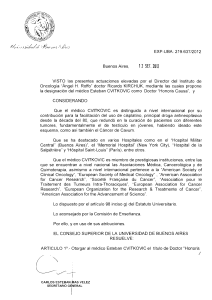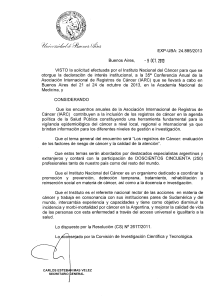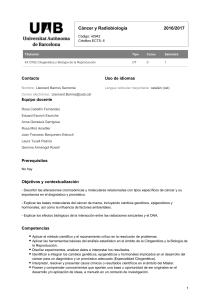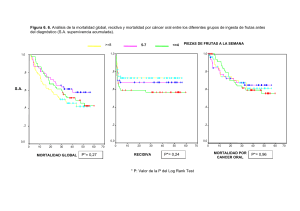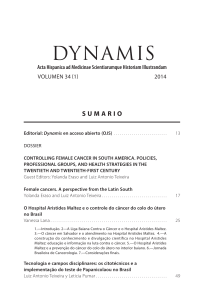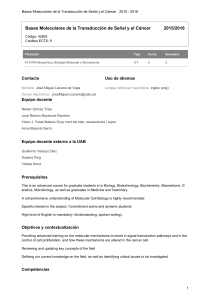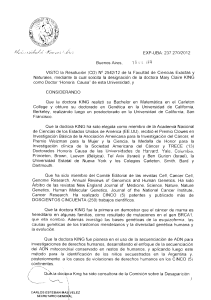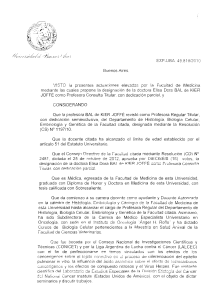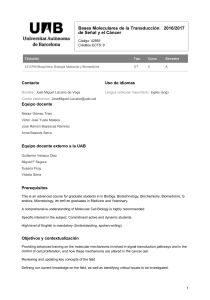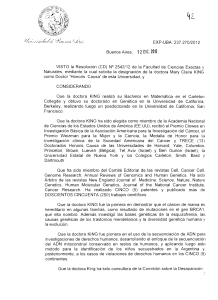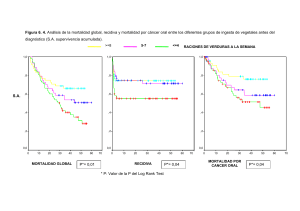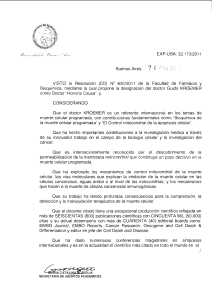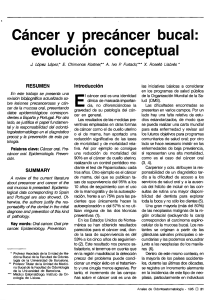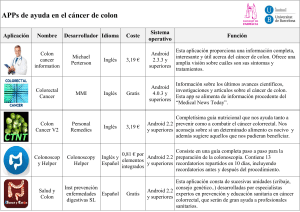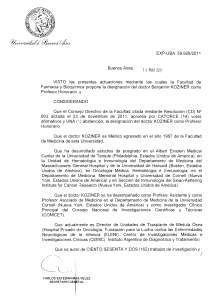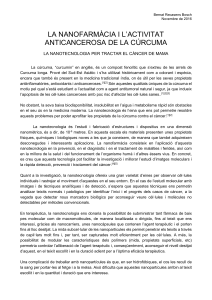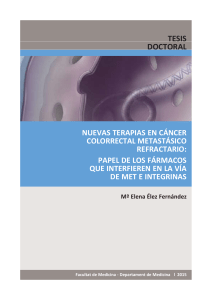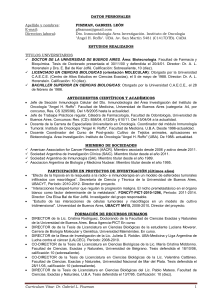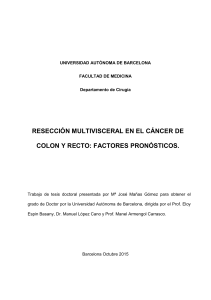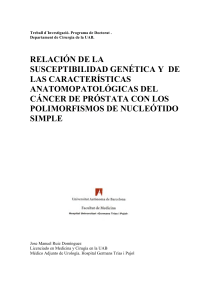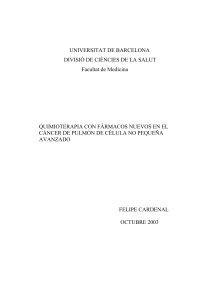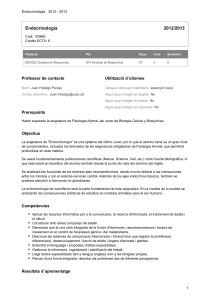04.MCS_4de4.pdf
publicité
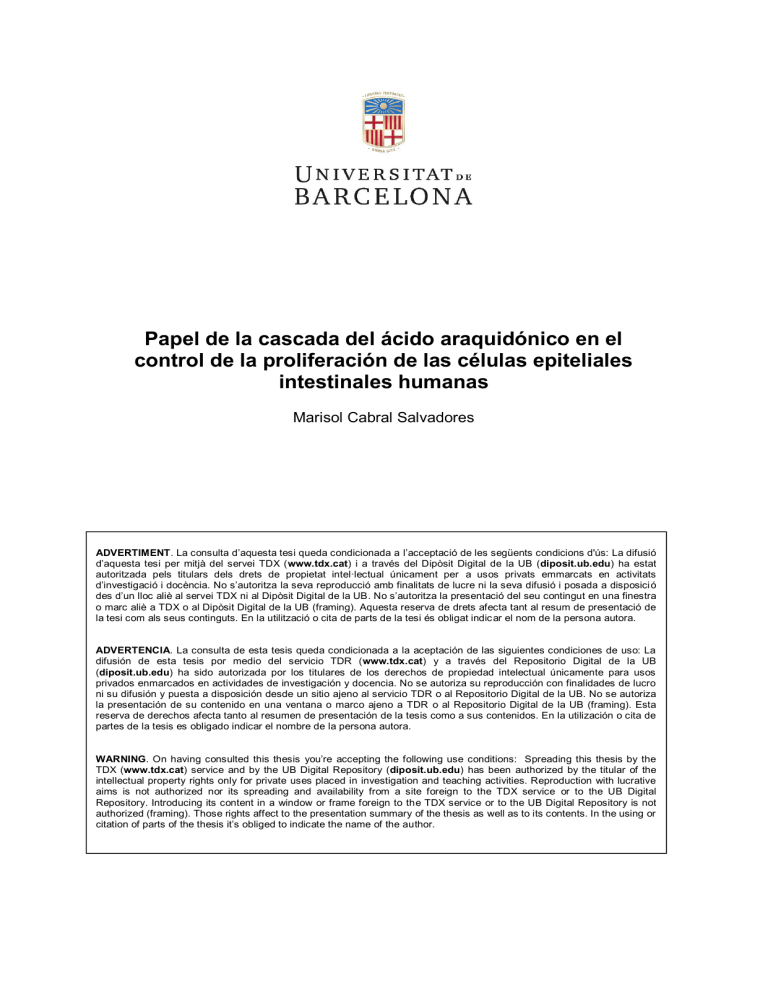
Papel de la cascada del ácido araquidónico en el control de la proliferación de las células epiteliales intestinales humanas Marisol Cabral Salvadores ADVERTIMENT. La consulta d’aquesta tesi queda condicionada a l’acceptació de les següents condicions d'ús: La difusió d’aquesta tesi per mitjà del servei TDX (www.tdx.cat) i a través del Dipòsit Digital de la UB (diposit.ub.edu) ha estat autoritzada pels titulars dels drets de propietat intel·lectual únicament per a usos privats emmarcats en activitats d’investigació i docència. No s’autoritza la seva reproducció amb finalitats de lucre ni la seva difusió i posada a disposici ó des d’un lloc aliè al servei TDX ni al Dipòsit Digital de la UB. No s’autoritza la presentació del seu contingut en una finestra o marc aliè a TDX o al Dipòsit Digital de la UB (framing). Aquesta reserva de drets afecta tant al resum de presentació de la tesi com als seus continguts. En la utilització o cita de parts de la tesi és obligat indic ar el nom de la persona autora. ADVERTENCIA. La consulta de esta tesis queda condicionada a la aceptación de las siguientes condiciones de uso: La difusión de esta tesis por medio del servicio TDR (www.tdx.cat) y a través del Repositorio Digital de la UB (diposit.ub.edu) ha sido autorizada por los titulares de los derechos de propiedad intelectual únicamente para usos privados enmarcados en actividades de investigación y docencia. No se autoriza su reproducción con finalidades de lucro ni su difusión y puesta a disposición desde un sitio ajeno al servicio TDR o al Repositorio Digital de la UB. No se autoriza la presentación de su contenido en una ventana o marco ajeno a TDR o al Repositorio Digital de la UB (framing). Esta reserva de derechos afecta tanto al resumen de presentación de la tesis como a sus contenidos. En la utilización o cita de partes de la tesis es obligado indicar el nombre de la persona autora. WARNING. On having consulted this thesis you’re accepting the following use conditions: Spreading this thesis by the TDX (www.tdx.cat) service and by the UB Digital Repository (diposit.ub.edu) has been authorized by the titular of the intellectual property rights only for private uses placed in investigation and teaching activities. Reproduction with lucrative aims is not authorized nor its spreading and availability from a site foreign to the TDX service or to the UB Digital Repository. Introducing its content in a window or frame foreign to the TDX service or to the UB Digital Repository is not authorized (framing). Those rights affect to the presentation summary of the thesis as well as to its contents. In the using or citation of parts of the thesis it’s obliged to indicate the name of the author. 5 CONCLUSIONES Conclusiones Las principales conclusiones de esta tesis doctoral son: - las células intestinales epiteliales (Caco-2) sintetizan eicosanoides a partir del AA a través de la vía de las COXs y de las LOXs, alcanzando concentraciones entre 1–10 nM, mientras que no producen cantidades cuantificables de eicosanoides derivados de la vía del CYP450. - la PGE2 y la PGE3, a través de la interacción con sus receptores EP 1 y EP4, activan de forma similar diversas vías de señalización como ERK, CREB y p38 e inducen la síntesis de DNA y la proliferación de las células Caco-2. - el LTD4 interacciona con el CisLT1R y activa ERK, CREB y β-catenina, provocando la proliferación de las células epiteliales intestinales. Estos efectos, a excepción de la desfosforilación de β-catenina, son PGE2-dependientes. - el LTB4, al interaccionar con el receptor BLT 1 y BLT2 y activar ERK, induce la proliferación de las células Caco-2, efecto que también es PGE2-dependiente. Sin embargo, el LTB5, derivado del EPA, no tiene este efecto mitogénico. - HETES como el 5-, 12- y 15-HETE, al interaccionar con el receptor BLT 2, activan la proliferación de las células Caco-2. El 12-HETE activa p38 y su efecto proliferativo es PGE 2dependiente. Un efecto similar tiene el 12-HEPE, derivado del EPA. - los enantiómeros del 9- y 13-HODE tienen efectos contrarios sobre la proliferación de las células Caco-2. Así, mientras los enantiómeros R inducen la proliferación a través de la interacción con los receptores BLT1 y BLT2 y la activación de la síntesis de PGE 2, los enantiómeros S son ligandos del PPARγ y tienen efectos antiproliferativos y proapotóticos. Teniendo en cuenta el conjunto de resultados que conforman esta tesis doctoral proponemos que el papel de la cascada del AA en la regulación de la proliferación de las células epiteliales intestinales es complejo, ya que hay diversos eicosanoides y receptores de eicosanoides implicados directa e indirectamente en el control del crecimiento de estas células (Figura 5.1). Además, existen metabolitos que presentan efectos opuestos, incluso enantiómeros de un mismo eicosanoide que tienen efectos contrarios sobre el control del crecimiento celular y de la apoptosis. No obstante, proporcionamos evidencias de que la acción mitogénica de todos estos metabolitos podría converger principalmente en 117 Conclusiones la activación de la vía COXs y la subsecuente síntesis de PGE 2, que por tanto jugaría un papel central en el control de la proliferación de las células epiteliales intestinales. Figura 5.1. Metabolitos de la cascada del AA que tienen efecto proliferativo y antiproliferativo en las células epiteliales intestinales no diferenciadas. 118 6 BIBLIOGRAFÍA Bibliografía A Akiba S, Sato T. Cellular function of calcium-independent phospholipase A2. Biol Pharm Bull. 2004; 27: 1174-1178. Alkayed NJ, Narayanan J, Gebremedhin D, Medhora M, Roman RJ, Harder DR. Molecular characterization of an arachidonic acid epoxygenase in rat brain astrocytes. Stroke. 1996; 27: 971-979. Aparoy P, Reddy KK, Reddanna P. Structure and ligand based drug design strategies in the development of novel 5- LOX inhibitors. Curr Med Chem. 2012; 19: 3763-378. Arnold C, Konkel A, Fischer R, Schunck WH. Cytochrome P450-dependent metabolism of omega-6 and omega-3 long-chain polyunsaturated fatty acids. Pharmacol Rep. 2010; 62: 536-547. Arenberger P. Kemény L, Ruzicka T. Characterization of high-affinity 12(S)-hydroxyeicosatetraenoic acid (12(S)-HETE) binding sites on normal human keratinocytes. Epithelial Cell Biol. 1993; 2: 1-6. Arterburn LM, Hall EB, Oken H. Distribution, interconversion, and dose response of n-3 fatty acids in humans. Am J Clin Nutr. 2006; 83(suppl): 1467-1476. B Backlund MG, Mann JR, Holla VR, Buchanan FG, Tai HH, Musiek ES, Milne GL, Katkuri S, DuBois RN. 15-Hydroxyprostaglandin dehydrogenase is down-regulated in colorectal cancer. J Bio Chem. 2005; 280: 3217-3223. Baer AN, Costello PB, Green FA. Stereospecificity of the hydroxyeicosatetraenoic and hydroxyoctadecadienoic acids produced by cultured bovine endothelial cells. Biochim Biophys Acta. 1991a; 1085: 45-52. Baer AN, Costello PB, Green FA. Stereospecificity of the products of thefatty acid oxygenases derived from psoriatic scales. J Lipid Res. 1991b; 32: 341-347. Bagga D, Wang L, Farias-Eisner R, Glaspy JA, Reddy ST. Differential effects of prostaglandin derived from omega-6 and omega-3 polyunsaturated fatty acids on COX-2 expression and IL-6 secretion. Proc Natl Acad Sci USA. 2003; 100: 1751-1756. Balboa MA, Balsinde J. Involvement of calcium-independent phospholipase A2 in hydrogen peroxideinduced accumulation of free fatty acids in human U937 cells. J Biol Chem. 2002; 277: 40384-40389. Balsinde J, Balboa MA, Insel PA, Dennis E A. Regulation and inhibition of phospholipase A 2. Annu Rev Pharmacol Toxicol. 1999; 39: 175-89. Bamia C, Lagiou P, Buckland G, Grioni S, Agnoli C, Taylor AJ, Dahm CC, Overvad K, Olsen A, Tjønneland A, Cottet V, Boutron-Ruault MC, Morois S, Grote V, Teucher B, Boeing H, Buijsse B, Trichopoulos D, Adarakis G, Tumino R, Naccarati A, Panico S, Palli D, Bueno-de-Mesquita HB, van Duijnhoven FJ, Peeters PH, Engeset D, Skeie G, Lund E, Sánchez MJ, Barricarte A, Huerta JM, Quirós JR, Dorronsoro M, Ljuslinder I, Palmqvist R, Drake I, Key TJ, Khaw KT, Wareham N, Romieu 121 Bibliografía I, Fedirko V, Jenab M, Romaguera D, Norat T, Trichopoulou A. Mediterranean diet and colorectal cancer risk: results from a European cohort. Eur J Epidemiol. 2013; 28: 317-328. Battu S, Clement G, Heyman M, Wal JM, Cook-Moreau J, Desjeux JF, Beneytout JL Production of arachidonic acid metabolites by the colon adenocarcinoma cell line HT29 cl.19A and their effect on chloride secretion. Cancer Lett. 1997; 116 : 213-223. Bayer M, Mosandl A, Thaçi D. Improved enantioselective analysis of polyunsaturated hydroxy fatty acids in psoriatic skin scales using highperformance liquid chromatography. J Chromatogr B Analyt Technol Biomed Life Sci . 2005; 819: 323-328. Baylin, A, Campos H. The use of fatty acid biomarkers to reflect dietary intake. Curr Opin Lipidol. 2006; 17: 22-27. Beaudoin F, Michaelson L, Hey S, Lewis M, Shewry P,Sayanova O. Heterologus reconstituition in yeast of the polyinsaturated fatty acid biosynthetic pathway. Proc Natl Acad Sci US . 2000; 97: 64216426. Bell RL,Kennerly DA, Stanford N y Majerus PW. Diglyderide lipasa: a pathway for arachidonate relase from human platelets. Proc Natl Acad Sci USA. 1979; 76: 3238-3241. Bishayee K, Khuda-Bukhsh AR. 5-lipoxygenase antagonist therapy: a new approach towards targeted cancer chemotherapy. Acta Biochim Biophys Sin. 2013; 45:709-719. Bittleman DB, Casale TB. 5-Hydroxyeicosatetraenoic acid (HETE)-induced neutrophil transcellular migration is dependent upon enantiomeric structure. Am J Respir Cell Mol Biol. 1995; 12: 260-267. Blonk MC, Bilo HJ, Nauta JJ, Popp-Snijders C, Mulder C, Donker AJ. Dose-response effects of fishoil supplementation in healthy volunteers. Am J Clin Nutr. 1990; 52:120-127. Boeglin W, Kim R, Brash A. A 12R-lipoxygenase in human skin: Mechanistic evidence, molecular cloning, and expression. Proc Natl Acad Sci USA. 1998; 95: 6744-6749. Bombardier C, Laine L, Reicin A, Shapiro D, Burgos-Vargas R, Davis B, Day R, Ferraz MB, Hawkey CJ, Hochberg MC, Kvien TK, Schnitzer TJ; VIGOR Study Group. Comparison of upper gastrointestinal toxicity of rofecoxib and naproxen in patients with rheumatoid arthritis. . N Engl J Med. 2000; 343: 1520-1528. Bortuzzo C, Hanif R, Kashfi K, Staiano-Coico L, Shiff SJ, Rigas B. The effect of leukotrienes B and selected HETEs on the proliferation of colon cancer cells. Biochim Biophys Acta. 1996; 1300: 240246. Brash A R, Boeglin W. E, Chang M S. Discovery of a second 15-S-lipoxygenase in humans. Proc. Natl Acad Sci USA. 1997; 94: 6148-6152. Bresalier RS, Sandler RS, Quan H, Bolognese JA, Oxenius B, Horgan K, Lines C, Riddell R, Morton D, Lanas A, Konstam MA, Baron JA. Cardiovascular events associated with rofecoxib in a colorectal adenoma chemoprevention trial. N Engl J Med. 2005; 352: 1092-1102. 122 Bibliografía Buecher B, Bouancheau D, Broquet A, Bezieau S, Denis MG, Bonnet C, Heymann MF, Jarry A, Galmiche JP, Blottière HM. Growth inhibitory effect of celecoxib and rofecoxib on human colorectal carcinoma cell lines. Anticancer Res. 2005; 25:225-233. Bull AW, Steffensen KR, Leers J, Rafter JJ. Activation of PPAR gamma in colon tumor cell lines by oxidized metabolites of linoleic acid, endogenous ligands for PPAR gamma. Carcinogenesis. 2003; 24: 1717-1722. Bylund J, Ericsson J, Oliw EH. Analysis of cytochrome P450 metabolites of arachidonic and linoleic acids by liquid chromatography-mass spectrometry with ion trap MS2. Anal Biochem. 1998; 265:5568. C Canavan C, Abrams KR, Mayberry J. Meta-analysis: colorectal and small bowel cancer risk in patients with Crohn's disease. Aliment Pharmacol Ther. 2006; 23: 1097-1104. Capdevila JH, Karara A, Waxman DJ, Martín MV, Falck JR y Guenguerich FP. Cytochrome P-450 enzyme-specific control of regio- and enantiofacial slectivity of the microsomal arachidonic acid epoxygenase. PJ Biol Chem. 1990; 265: 10865-10871. Capdevila JH, Falck JR, Harris RC. Cytochrome P450 and arachidonic acid bioactivation. Molecular and functional properties of the arachidonate monooxygenase. J Lipid Res. 2000; 41: 163-181. Castellone MC,Teramoto H J. Gutkind S. The β-Catenin Connection Cyclooxygenase-2 and Colorectal Cancer Chemoprevention: The β-Catenin Connection. Cancer Res. 2006; 66: 11085-11088. Catalano A, Procopio A. New aspects on the role of lipoxygenases in cancer progression. Histol Histopathol. 2005; 20: 969-975. Cathcart MC, Lysaght J, Pidgeon GP. Eicosanoid signalling pathways in the development and progression of colorectal cancer: novel approaches for prevention/intervention. Cancer Metastasis Rev. 2011; 30: 363-385. Chen FL, Wang XZ, Li JY, Yu JP, Huang CY, Chen ZX. 12-lipoxygenase induces apoptosis of human gastric cancer AGS cells via the ERK1/2 signal pathway. Dig Dis Sci. 2008; 53: 181-187. Chen GG, Xu H, Lee JF, Subramaniam M, Leung KL, Wang SH, Chan UP, Spelsberg TC. 15hydroxyeicosatetraenoic acid arrests growth of colorectal cancer cells via a peroxisome proliferator activated receptor gamma dependent pathway. Int J Cancer. 2003; 107: 837-843. Chen XS, Kurre U, Jenkins NA, Copeland NG, Funk CD. cDNA cloning, expression, mutagenesis of C-terminal isoleucine, genomic structure, and chromosomal localizations of murine 12-lipoxygenases. J Biol Chem. 1994; 269: 13979-13987. Cherukuri DP, Chen XB, Goulet AC, Young RN, Han Y, Heimark RL, Regan JW, Meuillet E, Nelson MA. The EP4 receptor antagonist, L-161,982, blocks prostaglandin E2-induced signal trans-duction and cell proliferation in HCA-7 colon cancer cells. Exp Cell Res. 2007; 313: 2969-2979. 123 Bibliografía Chulada PC, Thompson MB, Mahler JF, Doyle CM, Gaul BW, Lee C, Tiano HF, Morham SG, Smithies O, Langenbach R. Genetic disruption of Ptgs-1, as well as Ptgs-2, reduces intestinal tumorigenesis in Min mice. Cancer Res. 2000; 60: 4705-4708. Cianchi F, Cortesini C, Magnelli L, Fanti E, Papucci L, Schiavone N, Messerini L, Vannacci A, Capaccioli S, Perna F, Lulli M, Fabbroni V, Perigli G, Bechi P, Masini E. Inhibition of 5-lipoxygenase by MK886 augments the antitumor activity of celecoxib in human colon cancer cells. Mol Cancer Ther. 2006; 5: 2716-2726. Clevers H. The intestinal crypt, a prototype stem cell compartment. Cell. 2013; 154: 274-284. Cockbain AJ, Toogood GJ, Hull MA. Omega-3 polyunsaturated fatty acids for the treatment and prevention of colorectal cancer. Gut. 2012; 61: 135-149. Coleman R.A, Smith WL y Narumiya S. International Union of Pharmacology classification of prostanoid receptors: properties, distribution and structure of the receptors and their subtypes. Pharmacol. Rev. 1994; 146:205-229. Connor WE. Importance of n-3 fatty acids in health and disease. Am J Clin Nutr. 2000; 71: 171-175. Coronado M, Vega S, Gutiérrez R, Beatriz F, Díaz G. Los ácidos grasos omega-3 y omega-6. Nutrición, Bioquímica y Salud. 2006; 25: 72-79. Courtney ED, Matthews S, Finlayson C, Di Pierro D, Belluzzi A, Roda E,Kang JY, Leicester RJ. Eicosapentaenoic acid (EPA) reduces crypt cell proliferation and increases apoptosis in normal colonic mucosa in subjects with a history of colorectal adenomas. Int J Colorectal Dis. 2007; 22: 765-776. Coussens LM, Werb Z. Inflammation and cancer. Nature. 2002; 420: 860-867. Cuendet M, Pezzuto J M. The role of cyclooxygenase and lipoxygenase in cancer chemoprevention. Drug Metabol Drug Interact. 2000; 17 . 109–157. D Dannenberg AJ, Howe LR. The role of COX-2 in breast and cervical cancer. Prog Exp Tumor Res. 2003; 37: 90-106. Dauchy RT, Dauchy EM, Mao L, Belancio VP, Hill SM, Blask DE. A new apparatus and surgical technique for the dual perfusion of human tumor xenografts in situ in nude rats. Comp Med. 2012; 62: 99-108. Del Peso L, González-García M, Page C, Herrera R, Nuñez G. Interleukin-3 induced phosphorylation of BAD through the protein kinase Akt. Science. 1997; 278: 687-689. Dennis EA. Diversity of group types, regulation, and function of phospholipase A2. J Biol Chem. 1994; 269: 13057-60. Dennis EA. The growing phospholipase A2 superfamily of signal transduction enzymes. Trends Biochem Sci. 1997; 22: 1-2. 124 Bibliografía Ding X, Hu J, Li J, Zhang Y, Shui B, Ding Z, Yao L, Fan Y. Metabolomics analysis of collageninduced arthritis in rats and interventional effects of oral tolerance. Anal Biochem. 2014; 458: 49-57. Dixon RA, Diehl RE, Opas E, Rands E, Vickers PJ, Evans JF, Gillard JW, Miller DK. Requirement of a 5-lipoxygenase-activating protein for leukotriene synthesis. Nature. 1990; 343:282-284. Dixon DA, Blanco FF, Bruno A, Patrignani P. Mechanistic aspects of COX-2 expression in colorectal neoplasia. Recent Results. Cancer Res. 2013; 191:7-37. Dodge W, Thomas M. The effect of 5-hydroxyeicosatetraenoic acid on the proliferation of granulocyte progenitors and embryonic fibroblasts of the chick. Biochem Biophys Res Commun. 1985; 131:731735. E Eaden JA, Abrams KR, Mayberry JF. The risk of colorectal cancer in ulcerative colitis: a metaanalysis. Gut. 2001; 48: 526-535. Ekbom A, Helmick C, Zack M, Adami HO. Ulcerative colitis and colorectal cancer. A populationbased study. N Engl J Med. 1990; 323: 1228-1233. F Ferrer R, Moreno JJ. Role of eicosanoids on intestinal epithelial homeostasis. Biochem Pharmacol. 2010; 80: 431-438. Fodde R, Smits R, Clevers H. APC, signal transduction and genetic instability in colorectal cancer. Nat Rev Cancer. 2001; 1: 55-67. Fonteh AN, Bass DA, Marshall LA, Seeds M, Samet JM, Chilton FH. Evidence that secretory phospholipase A2 plays a role in arachidonic acid release and eicosanoid biosynthesis by mast cells. J Immunol. 1994; 152: 5438-5446. Fujishima H, Sánchez-Mejía R, Bingham CO, Lam BK, Sapirstein A, Bonventre JV, Austen KF, Arm JP. Cytosolic phospholipase A2 is essential for both the immediate and the delayed phases of eicosanoid generation in mouse bone marrow-derived mast cells. Proc Natl Acad Sci. U.S.A.1999; 96: 4803-4807. Funk CD, Furci L, FitzGerald GA. Molecular cloning, primary structure, and expression of the human platelet/erythroleukemia cell 12-lipoxygenase. Proc Natl Acad Sci U S A. 1990; 87: 5638-5642. Funk CD. Prostaglandins and leukotrienes: advances in eicosanoid biology. Science. 2001; 294: 18711875. G Galfi,P, Neogrady Z, Amberger A, Margreiter R, Csordas A. Sensitization of colon cancer cell lines to butyratemediatedproliferation inhibition by combined application ofindomethacin and nordihydroguaiaretic acid. Cancer Detect Prev. 2005; 29: 276-285. 125 Bibliografía Gao, X., Grignon D J, Chbihi T, Zacharek,A, Chen Y Q, Sakr, W, Porter A T, Crissman J D, Pontes J E, Powell I J, Honn K V. Elevated 12-lipoxygenase mRNA expression correlates with advanced stage and poor differentiation of human prostate cancer. Urology. 1995; 46: 227-237. Gately S, Li WW. Multiple roles of COX-2 in tumor angiogenesis: a target for antiangiogenic therapy. Semin Oncol. 2004; 31:2-11. Geerling BJ, van Houwelingen AC, Badart-Smook A, Stockbrugger RW, Brummer RJ. Fat intake and fatty acid profile in plasma phospholipids and adipose tissue in patients with Crohn’s disease, compared with controls. Am J Gastroenterol. 1999; 94: 410 -417. Goetzl EJ, An S, Smith WL. Specificity of expression and effects of eicosanoid mediators in normal physiology and human diseases. FASEB J. 1995; 9: 1051-1058. Gronert K, Clish CB, Romano M, Serhan CN. Transcellular regulation of eicosanoid biosynthesis. Methods Mol Biol. 1999; 120: 119-144. Grossi V, Peserico A, Tezil T, Simone C. p38α MAPK pathway: a key factor in colorectal cancer therapy and chemoresistance. World J Gastroenterol. 2014; 20: 9744-9758. Guo Y, Zhang W, Giroux C, Cai Y, Ekambaram P, Dilly AK, Hsu A, Zhou S, Maddipati KR, Liu J, Joshi S, Tucker SC, Lee MJ, Honn KV. Identification of the Orphan G Protein-coupled Receptor GPR31 as a Receptor for 12-(S)-Hydroxyeicosatetraenoic Acid. J Biol Chem. 2011; 286: 3383233840. Gupta RA, DuBois RN. Colorectal cancer prevention and treatment by inhibition of cyclooxygenase-2. Nat Rev Cancer. 2001; 1:11-21. H Hada T, Ueda N, Takahashi Y, Yamamoto S. Catalytic properties of human platelet 12-lipoxygenase as compared with the enzymes of other origins. Biochim Biophys Acta. 1991; 1083: 89-93. Hampson AJ, Grimaldi M. 12-hydroxyeicosatetrenoate (12-HETE) attenuates AMPA receptormediated neurotoxicity: evidence for a G-protein-coupled HETE receptor. J Neurosci. 2002; 22: 257264. Hanahan D, Weinberg RA. Hallmarks of cancer: The next generation. Cell. 2011; 144: 646-674. Hanel A, Schuttle S, Gelb M. Processive interfacial catalysis by mammalian 85-kilodalton phospholipase A2 enzymes on product-containing vesicles: aplication to the determination of substracte preferences. Biochemistry. 1993; 32: 5949-5958. Hansen HS. 15-hydroxyprostaglandin dehydrogenase. Prostaglandins. 1976; 12: 647-79. Hata AN, Breyer RM. Pharmacology and signaling of prostaglandin receptors: multiple roles in inflammation and immune modulation. Pharmacol Ther. 2004; 103: 147-166. 126 Bibliografía Harizi H. The immunobiology of prostanoid receptor signaling in connecting innate and adaptive immunity. Biomed Res Int. 2013; 2013: 683405. Hawcroft G, Ko CW, Hull MA. Prostaglandin E2-EP4 receptor signalling promotes tumorigenic behaviour of HT-29 human colorectal cancer cells. Oncogene. 2007; 26: 3006-3019. Hawcroft G, Loadman PM, Belluzzi A, Hull MA. Effect of eicosapentaenoic acid on E-type prostaglandin synthesis and EP4 receptor signaling in human colorectal cancer cells. Neoplasia. 2010; 12: 618-627. Heise CE, O’Dowd BF, Figueroa DJ, Sawyer N, Nguyen T, Im DS, Stocco R, Bellefeuille JN, Abramovitz M, Cheng R, Williams DL Jr, Zeng Z. Liu Q, Ma L, Clements MK, Coulombe N, Liu Y, Austin CP, George SR, O’Neill GP, Metters KM, Lynch KR, Evans JF. Characterization of the human cysteinyl leukotriene 2 receptor. J Biol Chem. 2000; 275: 30531-30536. Herschman HR. Regulationof prostaglandin synthase-1 and prostaglandin synthase-2. Cancer Metastasi Rev. 1994; 13: 241-256. Hirabayashi T, Murayama T, Shimizu T. Regulatory mechanism and physiological role of cytosolic phospholipase A2. Biol Pharm Bull. 2004; 27:1168-1173. Hirai H, Tanaka K, Yoshie O, Ogawa K, Kenmotsu K, Takamori Y, Ichimasa M, Sugamura K, Nakamura M, Takano S, Nagata K. Prostaglandin D2 selectively induces chemotaxis in T helper type 2 cells, eosinophils, and basophils via seven-transmembrane receptor CRTH2. J Exp Med. 2001; 193: 255-261. Hla T, Farrell M, Kumar A, Bailey JM. Isolation of the cDNA for human prostaglandin H synthase. Prostaglandins. 1986; 32: 829-845. Hla T, Neilson K. Human cyclooxygenase-2 cDNA. Proc Natl Acad Sci USA. 1992; 89: 7384-7388. Hong SH, Goh SH, Lee SJ, Hwang JA, Lee J, Choi IJ, Seo H, Park JH, Suzuki H, Yamamoto E, Kim IH, Jeong JS, Ju MH, Lee DH, Lee YS. Upregulation of adenylate cyclase 3 (ADCY3) increases the tumorigenic potential of cells by activating the CREB pathway. Oncotarget. 2013; 4: 1791-1803. Hörnsten L, Bylund J, Oliw EH. Bisallylic hydroxylation of linoleic and arachidonic acids by adult and fetal human liver microsomes and a comparison with human recombinant cytochromes P450. Adv Exp Med Biol. 1997; 433: 123-126. Hsi LC, Wilson LC, Eling TE. Opposing effects of 15-lipoxygenase-1 and -2 metabolites on MAPK signaling in prostate. Alteration in peroxisome proliferator-activated receptor gamma. J Biol Chem. 2002; 277: 40549-40556. Hull MA. Omega-3 polyunsaturated fatty acids. Best Pract Res Cl Ga. 2011; 25: 547-554. 127 Bibliografía I Ihara A, Wada K, Yoneda M, Fujisawa N, Takahashi H, Nakajima A. Blockade of leukotriene B4 signaling pathway induces apoptosis and suppresses cell proliferation in colon cancer. Cancer J Pharmacol Sci. 2007; 103: 24-32. Iizuka Y, Okuno T, Saeki K, Uozaki H, Okada S, Misaka T, Sato T, Toh H, Fukayama M, Takeda N, Kita Y, Shimizu T, Nakamura M, Yokomizo T. Protective role of the leukotriene B 4 receptor BLT2 in murine inflammatory colitis. FASEB J. 2010; 24: 4678-4690. IL Lee S, Zuo X, Shureiqi I. 15-Lipoxygenase-1 as a tumor suppressor gene in colon cancer: is the verdict in? Cancer Metastasis Rev. 2011; 30: 481-491. Imig JD, Inscho EW, Deichmann PC, Reddy KM, Falck JR. Afferent arteriolar vasodilation to the sulfonimide analog of 11, 12-epoxyeicosatrienoic acid involves protein kinase A. Hypertension. 1999. 33: 408-413. Irvine RF. How is the level of free arachidonic acid controlled in mammalian cells? Biochem J. 1982; 204: 3-16. J Jacoby RF, Seibert K, Cole CE, Kelloff G, Lubet RA. The cyclooxygenase-2 inhibitor celecoxib is a potent preventive and therapeutic agent in the min mouse model of adenomatous polyposis. Cancer Res. 2000; 60: 5040-5044. Jemal A, Bray F, Center MM, Ferlay J, Ward E, Forman D. Global cancer statistics. Cancer J Clin. 2011; 61: 69-90. Jiang WG, Douglas-Jones AG, Mansel RE. Aberrant expression of 5-lipoxygenase-activating protein (5-LOXAP) has prognostic and survival significance in patients with breast cancer. Prostaglandins Leukot Essent Fatty Acids. 2006; 74: 125-134. Jones RL, Giembycz MA, Woodward DF. Prostanoid receptor antagonists: development strategies and therapeutic applications. Br J Pharmacol. 2009; 158: 104-145. Ju J, Hong J, Zhou JN, Pan Z, Bose M, Liao J, Yang GY, Liu YY, Hou Z, Lin Y, Ma J, Shih WJ, Carothers AM, Yang CS. Inhibition of intestinal tumorigenesis in Apcmin/+ mice by (-)epigallocatechin-3-gallate, the major catechin in green tea. Cancer Res. 2005; 65: 10623-10631. Junttila MR, Evan GI. P53--a Jack of all trades but master of none. Nat Res Cancer. 2009; 9: 821-829. K Kamitani H, Geller M, Eling T. Expression of 15-lipoxygenase by human colorectal carcinoma Caco-2 cell lines during apoptosis and cell differentiation. J Biol Chem. 1998; 273: 21569-21577. 128 Bibliografía Kaneko F, Zhang JZ, Maruyama K, Nihei Y, Ono I, Iwatsuki K y Yamamoto T. Prostaglandi I1 ananlogues, SM-10902 and SM-10906, affect human keratinocytes and friboblasts in vitro in a manner similar to PGE1: therapeutic potential for wound healding. Arch Dermatol Res. 1995; 287: 539-545. Kang KH, Ling TY, Liou HH, Huang YK, Hour MJ, Liou HC, Fu WM. Enhancement role of host 12/15-lipoxygenase in melanoma progression. Eur J Cancer. 2013; 49: 2747-2759. Kaur J, Sanyal SN. PI3-kinase/Wnt association mediates COX-2/PGE(2) pathway to inhibit apoptosis in early stages of colon carcinogenesis: chemoprevention by diclofenac. Tumour Biol. 2010; 31:623631. Kearney PM, Baigent C, Godwin J, Halls H, Emberson J R, Patrono C. Do selective cyclo-oxygenase2 inhibitors and traditional non-steroidal anti-inflammatory drugs increase the risk of atherothrombosis? Meta-analysis of randomised trials. BMJ. 2006; 332: 1302-1308. Kim HJ, Kim DK, Kim H, Koh JY, Kim KM, Noh MS, Lee S, Kim S, Park SH, Kim JJ, Kim SY, Lee CH. Involvement of the BLT2 receptor in the itch-associated scratching induced by 12-(S)lipoxygenase products in ICR mice. Br J Pharmacol. 2008; 154: 1073-1078. Kiriyama M, Ushikubi F, Kobayashi T, Hirata M, Sugimoto Y, Narumiya S. Ligand binding specificities of the eight types and subtypes of the mouse prostanoid receptors expressed in Chinese hamster ovary cells. Br J Pharmacol. 1997; 122: 217-224. Kis B, Snipes JA, Isse T, Nagy K, Busija DW. Putative cyclooxygenase-3 expression in rat brain cells. J Cereb Blood Flow Metab. 2003; 23: 1287-1292. Kraemer SA, Meade EA, DeWitt DL. Prostaglandin endoperoxide synthase gene structure: identification of the transcriptional start site nd 5’-flanking regulatory sequences. Arch Biochem Biophys. 1992; 293: 391-400. Kuhn H, Thiele BJ. The diversity of the lipoxygenase family. Many sequence data but little information on biological significance. FEBS Lett. 1999; 449:7-11. Kuhn H, Walther M, Kuban RJ. Mammalian arachidonate 15-lipoxygenases structure, function, and biological implications. Prostaglandins Other Lipid Mediat. 2002; 68: 263-290. Kujubu DA, Fletcher BS, Varmun BC, Lim RW, Herschman HR. 1991.TIS10, a phorbol ester tumor promoter-inducible mRNA from Swiss 3T3 cell, encodes a novel prostaglandin synthase/cyclooxygenase homolog. J Biol Chem. 1991; 266: 12866-12872. Kune GA, Kune S, Watson LF. Colorectal cancer risk, chronic illnesses, operations, and medications: case control results from the Melbourne Colorectal Cancer Study. Cancer Res. 1988; 48: 4399-4404. Kurahashi Y, Herbertsson H, Söderström M, Rosenfeld MG, Hammarström S. A 12(S)hydroxyeicosatetraenoic acid receptor interacts with steroid receptor coactivator-1. Biochimestry. 2000; 97: 5779-5783. Kushi LH, Lenart EB, Willett WC. Health implications of Mediterranean diets in light of contemporary knowledge. Meat, wine, fats, and oils. Am J Clin Nutr. 1995; 61: 1416-1427. 129 Bibliografía L Lawrence RA, Jones RL, Wilson NH. Characterization of receptors involved in the direct and indirect actions of prostaglandins E and I on the guinea-pig ileum. Br J Pharmacol. 1992; 105: 271-278. Lecomte M, Laneuville O, Ji C, DeWitt DL, Smith WL. Acetylation of human prostaglandin endoperoxide synthase-2 (cyclooxygenase-2) by aspirin. J Biol Chem. 1994; 269: 13207-13215. Lee SP, Serezani CH, Medeiros AI, Ballinger MN, Peters-Golden M. Crosstalk between prostaglandin E2 and leukotriene B4 regulates phagocytosis in alveolar macrophages via combinatorial effects on cyclic AMP. J Immmunol. 2009: 182: 530-537. Le Faouder P, Baillif V, Spreadbury I, Motta JP, Rousset P, Chêne G, Guigné C, Tercé F, Vanner S, Vergnolle N, Bertrand-Michel J, Dubourdeau M, Cenac N. LC-MS/MS method for rapid and concomitant quantification of pro-inflammatory and pro-resolving polyunsaturated fatty acid metabolites. J Chromatogr B Analyt Technol Biomed Life Sci. 2013; 932: 123-133. Leidl K, Liebisch G, Richter D, Schmitz G. Mass spectrometric analysis of lipid species of human circulating blood cells. Biochim Biophys Acta. 2008; 1781: 655-664. Leone V, di Palma A, Ricchi P, Acquaviva F, Giannouli M, Di Prisco AM, Iuliano F, Acquaviva AM. PGE2 inhibits apoptosis in human adenocarcinoma Caco-2 cell line through Ras-PI3K association and cAMP-dependent kinase A activation. Am J Physiol Gastrointest Liver Physiol. 2007; 293: 673-681. Leslie CC. Properties and regulation of cytosolic phospholipase A2. J Biol Chem. 1997; 272: 1670916712. Levy BD, De Sanctis GT, Devchand PR, Kim E, Ackerman K, Schmidt BA, Szczeklik W, Drazen JM, Serhan CN. Multi-pronged inhibition of airway hyper-responsiveness and inflammation by lipoxin A(4). Nat Med. 2002; 8: 1018-1023. Li PL, Chen CL, Bortell R, Campbell WB. 11, 12-Epoxyeicosatrienoic acid stimulates endogenous mono-ADP-ribosylation in bovine coronary arterial smooth muscle. Circ Res. 1999; 85: 349-356. Liu B, Khan WA, Hannun YA, Timar J, Taylor JD, Lundy S, Butovich I, Honn KV. 12(S)hydroxyeicosatetraenoic acid and 13(S)-hydroxyoctadecadienoic acid regulation of protein kinase Calpha in melanoma cells: role of receptor-mediated hydrolysis of inositol phospholipids. Proc Natl Acad Sci. 1995; 9: 9323-9327. Liu ES, Ye YN, Shin VY, Yuen ST, Leung SY, Wong BC, Cho CH . Cigarette smoke exposure increases ulcerative colitis associated colonic adenoma formation in mice. Carcinogenesis. 2003; 24: 1407-1413. Lynch KR, O'Neill GP, Liu Q, Im DS, Sawyer N, Metters KM, Coulombe N, Abramovitz M, Figueroa DJ, Zeng Z, Connolly BM, Bai C, Austin CP, Chateauneuf A, Stocco R, Greig GM, Kargman S, Hooks SB, Hosfield E, Williams DL Jr, Ford-Hutchinson AW, Caskey CT, Evans JF. Characterization of the human cysteinyl leukotriene CysLT1 receptor. Nature. 1999; 399: 789-793. 130 Bibliografía M MacLean CH, Newberry SJ, Mojica WA, Khanna P, Issa AM, Suttorp MJ, Lim YW, Traina SB, Hilton L, Garland R, Morton SC. Effects of omega-3 fatty acids on cancer risk: a systematic. JAMA. 2006; 295: 403-415. Mahadevappa V, Holub B. Quantitative loss of individual eicosapentaenoyl-relative to arachidonoylcontaining phospholipids in thrombin-stimulated human platelets. J Lipid Res. 1987; 28: 1275-1280. Magnusson C, Ehrnström R, Olsen J. An increased expression of cysteinyl leukotriene 2 receptor in colorectal adenocarcinomas correlates with high differentiation. Cancer Res. 2007; 67: 9190-9198. Mal M, Koh P K, Cheah PY, Chan E C. Ul-trapressure liquid hromatography/tandem mass spectrometry targeted profiling of arachidonic acid and eicosanoids in human colorectal cancer. Rapid Commun Mass Spectrom. 2011; 25: 755-764. Magnusson C, Mezhybovska M, Lörinc E, Fernebro E, Nilbert M, Sjölander A. Low expression of CysLT1R and high expression of CysLT2R mediate good prognosis in colorectal cancer. Eur J Cancer. 2010; 46: 826-835. Mancini JA, Waterman H, Riendeau D. Cellular oxygenation of 12-hydroxyeicosatetraenoic acid by 5lipoxygenase is stimulated by 5-lipoxygenase-activating protein. J Biol Chem. 1998; 273: 3284232847. Mann JR, DuBois RN. Cyclooxygenase-2 and gastrointestinal cancer. Cancer J. 2004; 10: 145-152. Martín-Venegas R, Roig-Pérez S, Ferrer R, Moreno JJ. Arachidonic acid cascade and epithelial barrier function during Caco-2 cell differentiation. J Lipid Res. 2006; 47: 1416-1423. Martin-Venegas R, Casillas R, Jáuregui O, Moreno JJ. Rapid simultaneous analysis of cyclooxygenase, lipoxygenase and cytochrome P-450 metabolites of arachidonic and linoleic acids using high performance liquid chromatography/mass spectrometry in tandem mode. J Pharm Biomed Anal. 2011; 56: 976-982. Martin-Venegas R, Jauregui O, Morenoa JJ. Liquid chromatography-tandem mass spectrometry analysis of eicosanoids and related compounds in cell models. J Chromatogr B. 2014; 964: 41-49. Martínez J, Moreno JJ. Role of Ca2+-independent phospholipase A2 on arachidonic acid release induced by reactive oxygen species. Arch Biochem Biophys. 2001; 392: 257-262. McDonnell M, Davis W Jr, Li H, Funk CD. Characterization of the murine epidermal 12/15lipoxygenase. Prostaglandins Other Lipid Mediat. 2001; 63: 93-107. Melstrom LG, Bentrem DJ, Salabat MR, Kennedy TJ, Ding XZ, Strouch M, Rao SM, Witt RC, Ternent CA, Talamonti MS, Bell RH, Adrian TA. Overexpression of 5-Lipoxygenase in Colon Polyps and Cancer and the Effect of 5-LOX Inhibitors In vitro and in a Murine Model. Clin Cancer Res. 2008; 14:6525-6530. 131 Bibliografía Miller TM, Donnelly MK, Grago EA, Roman DM, Sherwood PR, Horowitz MB, Poloyac SM. Rapid, simultaneous quantitation of mono and dioxygenated metabolites of arachidonic acid in human CSF and rat brain. J Chromatogr B Analyt Technol Biomed Life Sci. 2009; 877: 3991-4000. Mizuno H, Sakamoto C, Matsuda K, Wada K, Uchida T, Noguchi H, Akamatsu T, Kasuga M. Induction of cyclooxygenase 2 in gastric mucosal lesions and its inhibition by the specific antagonist delays healing in mice. Gastroenterology. 1997; 112: 387-397. Mohammed A, Janakiram NB, Li Q, Choi CI, Zhang Y, Steele VE, Rao CV. Chemoprevention of colon and small intestinal tumorigenesis in APC(Min/+) mice by licofelone, a novel dual 5-LOX/COX inhibitor: potential implications for human colon cancer prevention. Cancer Prev Res (Phila). 2011; 4: 2015-2026. Moser AR, Luongo C, Gould KA, McNeley MK, Shoemaker AR, Dove WF. ApcMin: a mouse model for intestinal and mammary tumorigenesis. Eur J Cancer. 1995; 7: 1061-1064. Moreno JJ. Regulation of arachidonic acid release and prostaglandin formation by cell-cell adhesive interactons in wound repair. Pflügers Arch. 1997; 433: 351-356. Moreno JJ. Differential effects of arachidonic and eicosapentaenoic Acid-derived eicosanoids on polymorphonuclear transmigration across endothelial cell cultures. J Pharmacol Exp Ther. 2009; 33: 1111-1117. Moriguchi T, Lim SY, Greiner R, Lefkowitz W, Loewke J, Hoshiba J, Salem N Jr. Effects of an n-3 deficient diet on brain, retina, and liver fatty acyl composition in artificially rearedrats. J Lipid Res. 2004; 45: 1437-45. Morita I, Takahashi R, Salto Y, Murota S. Stimulation of eicosapentaenoic acid metabolism in washed human platelets by 12-hydroperoxyeicosatetraenoic acid. J Biol Chem. 1983; 258: 10197-10199. Muller-Decker K, Neufang G, Berger I, Neumann M, Marks F, Furstenberger G. Transgenic cyclooxygenase-2 overexpression sensitizes mouse skin for carcinogenesis. Proc Natl Acad Sci USA. 2002; 99: 12483-12488. Murakami M, Shimbara S, Kambe T, Kuwata H, Wistead MV, Tischfield JA, Kudo I. The functions of five distinct mammalian phospholipase A2S in regulating arachidonic acid release. Type IIa and type V secretory phospholipase A2S are functionally redundant and act in concert with cytosolic phospholipase A2. J Biol Chem. 1998; 273: 14411-14423. Muthalif MM, Uddin MR, Fatima S, Parmentier JH, Khandekar Z, Malik KU. Small GTP binding protein Ras contributes to norepinephrine-induced mitogenesis of vascular smooth muscle cells. Prostaglandins Other Lipid Mediat. 2001; 65: 33-43. N Narko K, Ritvos O, Ristimäki A. Induction of cyclooxygenase-2 and prostaglandin F2alpha receptor expression by interleukin-1beta in cultured human granulosa-luteal cells. Endocrinology. 1997; 138: 3638-3644. 132 Bibliografía Narumiya S. Prostanoid receptors and signal transduction. Prog Brain Res. 1996; 113: 231-241. Natarajan R, Reddy MA. HETEs/EETs in renal glomerular and epithelial cell functions. Curr Opin Pharmacol. 2003; 3: 198-203. Natarajan R, Nadler JL. Lipid inflammatory mediators in diabetic vascular disease. Arterioscler Thromb Vasc Biol. 2004; 24: 1542-1548. Needleman P, Minkes M, Raz A. Thromboxanes: Selective biosynthesis and distinct biological properties. Science. 1976; 193: 163-165. Needleman P, Whitaker MO, Wyche A. Watters K, Sprecher H, Raz A. Manipulation of platet aggregation by prostaglandin and their fatty acid precusors: pharmacological basis for a therapeutic approach. Prostaglandins. 1980; 19: 165-181. Negus RP, Stamp GW, Hadley J, Balkwill FR. Quantitative assessment of the leukocyte infiltrate in ovarian cancer and its relationship to the expression of C-C chemokines. Am J Pathol. 1997; 150: 1723-3174. Neilson A, Djuric Z, Ren J, Hong Y, Sen A, Lager C, Jiang Y, Reuven S, Smith W, Brenner D. Effect of cylooxygenase genotype and dietary fish oil on colonic eicosanoids in mice. J Nutr Biochem. 2012; 23: 966-976. Nelson DR, Koymans L, Kamataki T, Stegeman JJ, Feyereisen R, Waxman DJ, Waterman MR, Gotoh O, Coon MJ, Estabrook RW, Gunsalus IC, Nebert DW. P450 superfamily: update on new sequences, gene mapping, accession numbers and nomenclature. Pharmacogenetics. 1996; 6: 1-42. Nielsen CK, Ohd JF, Wikström K, Massoumi R, Paruchuri S, Juhas M, Sjölander A. The leukotriene receptor CysLT1 and 5-lipoxygenase are upregulated in colon cancer. Adv Exp Med Biol. 2003; 525: 201-204. Nielsen CK, Campbell JI, Ohd JF, Mörgelin M, Riesbeck K, Landberg G, Sjölander A. A novel localization of the G-protein-coupled CysLT1 receptor in the nucleus of colorectal adenocarcinoma cells. Cancer Res. 2005; 65:732-742. Nieves D, Moreno JJ. Enantioselective effect of 12(S)-hydroxyeicosatetraenoic acid on 3T6 fibroblast growth through ERK 1/2 and p38 MAPK pathways and cyclin D1 activation. Biochem Pharmacol. 2008; 76: 654-661. Nithipatikom K, Laabs ND, Isbell MA, Campbell WB. Liquid chromatographic–mass spectrometric determination of cyclooxygenase metabolites of arachidonic acid in cultured cells. J Chromatogr B Analyt Technol Biomel Life Sci. 2003; 785: 135-145. Nixon JB, Kamitani H, Baek SJ, Eling TE. Evaluation of eicosanoids and NSAIDs as PPARgamma ligands in colorectal carcinoma cells. Prostaglandins Leukot Essent Fatty Acids. 2003; 68: 323-330. Nixon JB, Kim KS, Lamb PW, Bottone FG, Eling TE. 15-Lipoxygenase-1 has anti-tumorigenic effects in colorectal cancer. Prostaglandins Leukot Essent Fatty Acids. 2004; 70: 7-15. 133 Bibliografía Norat T, Riboli E. Meat consumption and colorectal cancer: a review of epidemiologic evidence. Nutr Rev. 2001; 59: 37-47. O Öhd JF, Wikström K, Sjölander.A. Leukotrienes induce cell-survival signaling in intestinal epithelial cells. Gastroenterology. 2000; 119: 1007-1018. Öhd JF, Nielsen CK, Campbell J, Landberg G, Löfberg H, Sjölander A. Expression of the leukotriene D4 receptor CysLT1, COX-2, and other cell survival factors in colorectal adenocarcinomas. Gastroenterology. 2003; 124: 57-70. Okuno T, Ishitani T, Yokomizo T. Biochemical characterization of three BLT receptors in zebrafish. PLoS One. 2015; 10: e0117888 Oliw EH, Brodowsky ID, Hörnsten L, Hamberg M. Bis-allylic hydroxylation of polyunsaturated fatty acids by hepatic monooxygenases and its relation to the enzymatic and nonenzymatic formation of conjugated hydroxyl fatty acids. Arch Biochem Biophys. 1993; 300: 434-439. Oshima M, Dinchuk JE, Kargman SL, Oshima H, Hancock B, Kwong E, Trzaskos JM, Evans JF y Taketo MM. Suppression of intestinal polyposis in Apc delta716 knockout mice by inhibition of cyclooxygenase 2 (COX-2). Cell. 1996; 87: 803-809. P Pace-Asciak CR. The hepoxilins and some analogues: a review of their biology. Br J Pharmacol. 2009; 158: 972-981. Pai R, Soreghan B, Szabo IL, Pavelka M, Baatar D, Tarnawski AS. Prostaglandin E 2 transactivates EGF receptor: a novel mechanism for promoting colon cancer growth and gastrointestinal hypertrophy. Nat Med. 2002; 8: 289-293. Parhamifar L, Jeppsson B, Sjölander A. Activation of cPLA 2 is required for leukotriene D4-induced proliferation in colon cancer cells. Carcinogenesis. 2005; 26: 1988-1998.. Park JM, Kanaoka Y, Eguchi N, Aritake K, Grujic S, Materi AM, Buslon VS, Tippin BL, Kwong AM, Salido E, French SW, Urade Y, Lin HJ. Hematopoietic prostaglandin D synthase suppresses intestinal adenomas in ApcMin/+ mice. Cancer Res. 2007; 67: 881-889. Paruchuri S, Sjölander A. Leukotriene D4 mediates survival and proliferation via separate but parallel pathways in the human intestinal epithelial cell line Int 407. J Biol Chem. 2003; 278: 45577- 45585. Paruchuri S, Broom O, Dib K, Sjölander A. The proinflammatory mediator leukotriene D4 induces phosphatidylinositol 3-kinase and Rac-dependent migration of intestinal epithelial cells. J Biol Chem. 2005; 280: 13538-13544. Paruchuri S, Mezhybovska M, Juhas M, Sjölander A. Endogenous production of leukotriene D4 mediates autocrine survival and proliferation via CysLT1 receptor signalling in intestinal epithelial cells. Oncogene. 2006; 25: 6660-6665. 134 Bibliografía Pearson T, Warren AY, Barrett DA, Khan RN. Detection of EETs and HETE-generating cytochrome P-450 enzymes and the effects of their metabolites on myometrial and vascular function. Am J Physiol Endocrinol Metab. 2009; 297: 647-656. Peddareddigari VG, Wang D, Dubois RN. The tumor microenvironment in colorectal carcinogenesis. Cancer Microenviron. 2010; 3: 149-166. Peifer M. Colon construction. Nature. 2002; 410: 274-275. Petrik M, McEntee M, Chiu C, Whelan J. Antagonism of arachidonic acid is linked to the antitumorigenic effect of dietary eicosapentaenoic acid in Apc(Min/+) mice. J Nutr. 2000; 130: 11531158. Plante H, Picard S, Mancini J, Borgeat P. 5-Lipoxygenase-activating protein homodimer in human neutrophils: evidence for a role in leukotriene biosynthesis. Biochem J. 2006; 393: 211-218. Porenta SR, Ko YA, Gruber SB, Mukherjee B, Baylin A, Ren J, Djuric Z. Interaction of fatty acid genotype and diet on changes in colonic fatty acids in a Mediterranean diet intervention study. Cancer Prev Res (Phila). 2013; 6: 1212-1221. Prasad A R, Prasad S, Nguyen H, Facista A, Lewis C, Zaitlin B, Bernstein H. Novel diet-related mouse model of colon cancer parallels human colon cancer. World J Gastrointest Oncol. 2014; 6: 225-243. R Regan JW. EP2 and EP4 prostanoid receptor signaling. Life Sci. 2003; 74: 143-153.. Repasky GA, Zhou Y, Morita S, Der CJ. Ras-mediated intestinal epithelial cell transformation requires cyclooxygenase-2-induced prostaglandin E2 signaling. Mol Carcinog. 2007; 46: 958-970. Reuter BK, Asfaha S, Buret A, Sharkey KA y Wallace JL. Exacerbation of inflammation associated colonic injuty in rat through inhibition of cyclooxygenese-2. J Clin Invest. 1996; 98: 2076-2085. Rigas B, Goldman IS, Levine L. Altered eicosanoid levels in human colon cancer. J Lab Clin Med. 1993; 122: 518-523. Roberts LJ 2nd, Sweetman BJ. Metabolic fate of endogenously synthesized prostaglandin D2 in a human female with mastocytosis. Prostaglandins. 1985; 30: 383-400. Rodríguez-Lagunas MJ, Martín-Venegas R, Moreno JJ, Ferrer R. PGE2 promotes Ca2+ mediated epithelial barrier disruption through EP1and EP4 receptors in Caco-2 cell monolayers. Am J Physiol Cell Physiol. 2010; 299: 324-334. Roynette CR, Calderb PC, Dupertuisa YM,Picharda C. n-3 Polyunsaturated fatty acids and colon cancer prevention. Clin Nutr. 2004; 23: 139-151. Rubinfeld B, Albert I, Porfiri E, Fiol C, Munemitsu S, Polakis P. Binding of GSK3beta to the APCbeta-catenin complex and regulation of complex assembly. Science. 1996; 272: 1023-1026. 135 Bibliografía S Salem N, Shingu T, Kim HY, Hullin F, Bougnoux P, Karanian JW. Specialization in membrane structure and metabolism with respect to polyunsaturated lipids. Prog Clin Biol Res. 1988; 282: 319333. SalimaT, Sand-Dejmeka J, Sjölander A. The inflammatory mediator leukotriene D4 induces subcellular β-catenin translocation and migration of colon cancer cells. Exp Cell Res. 2014; 321: 255 266. Sanchez T, Moreno JJ. The effect of high molecular phospholipase A2 inhibitors on 3T6 fibroblast proliferation. Biochem Pharmacol. 2001; 61: 811-816. Sargent JR. Fish oils and human diet. Br J Nutr. 1997; 78: S5–S13. Sauer LA, Dauchy RT, Blask DE, Armstrong BJ, Scalici S. 13-Hydroxyoctadecadienoic acid is the mitogenic signal for linoleic acid dependent growth in rat hepatoma 7288CTC in vivo. Cancer Res. 1999; 59: 4688-4692. Schaloske R H, Provins JW, Kessen UA, Dennis EA. Molecular characterization of the lipopolysaccharide/platelet activating factor- and zymosan-induced pathways leading to prostaglandin production in P388D1 macrophages. Biochim Biophys Acta. 2005; 1687: 64-75. Serhan CN, Chiang N, Van Dyke TE. Resolving inflammation: Dual anti-inflammatory and proresolution lipid mediators. Nat Rev Immunol. 2008; 8: 349-361. Seya A, Terano T, Tamura Y, Yoshida S. Comparative effect of leukotriene B4 and leukotriene B5 on calcium mobilization in human neutrophils. Prostaglandins Leukot Essent Fatty Acids. 1988; 34: 4750. Shao J, Jung C, Liu C, Sheng H. Prostaglandin E 2 Stimulates the beta-catenin/T cell factor-dependent transcription in colon cancer. J Biol Chem. 2005; 280: 26565-26572. Sharma RK, Doig MV, Lewis DF, Gibson GG. Role of hepatic and renal cytochrome P-450 IVA1 in the metabolism of lipid substrates. Biochem Pharmacol. 1989; 38: 3621-369. Shaywitz AJ, Greenberg ME. CREB: a stimulus-induced transcription factor activated by a diverse array of extracellular signals. Annu Rev Biochem. 1999; 68: 821-861. Shibata N, Toi S, Shibata T, Uchida K, Itabe H, Sawada T, Kawamata T, Okada Y, Uchiyama S, Kobayashi M. Immunohistochemical detection of 13(R)-hydroxyoctadecadienoic acid in atherosclerotic plaques of human carotid arteries using a novel specific antibody. Acta Histochem Cytochem. 2009; 42: 19-203. Shureiqi I, Wojno KJ, Poore JA, Reddy RG, Moussalli MJ, Spindler SA, Greenson JK, Normolle D, Hasan AA, Lawrence TS, Brenner DE. Decreased 13-S hydroxyoctadecadienoic acid levels and 15lipoxygenase-1 expression in human colon cancers. Carcinogenesis. 1999; 20: 1985-1995. 136 Bibliografía Shureiqi I, Lippman SM. Lipoxygenase modulation to reverse carcinogenesis. Cancer Res. 2001; 61: 6307-6312. Shureiqi I, Chen D, Day RS, Zuo X, Hochman FL, Ross WA, Cole RA,Moy O, Morris JS, Xiao L, Newman RA, Yang P, Lippman SM. Profiling lipoxygenase metabolism in specific steps of colorectal tumorigenesis. Cancer Prev Res. 2010; 3: 829-838. Siegel R, Naishadham D, Jemal A. Cancer statistics. CA Cancer J Clin. 2012; 62: 10-29. Simmons DL, Botting RM, Hla T. Cyclooxygenase isozymes: the biology of prostaglandin synthesis and inhibition. Pharmacol Rev. 2004; 56: 387-437. Six DA, Dennis EA. The expanding superfamily of phospholipase A2 enzymes: classification and characterization. Biochim Biophys Acta. 2000; 1488: 1-19. Smith WL, Garavito RM, DeWitt DL. Prostaglandin endoperoxide H synthases (cyclooxygenases)-1 and -2. J Biol Chem. 1996; 271: 33157-33160. Smith WL. Cyclooxygenase, peroxide tone and the allure of fish oil. Curr Opin Cell Biol. 2005; 17: 174–182. Smith WL, Urade Y, Jakobsson PJ. Enzymes of the cyclooxygenase pathways of prostanoid biosynthesis. Chem Rev. 2011; 111: 5821-5865. Sobolewski C, Cerella C, Dicato M, Ghibelli L, Diederich M. The role of cyclooxygenase-2 in cell proliferation and cell death in human malignancies. Int J Cell Biol. 2010; 2010: 215158. Sociedad Española de Oncología Médica: SEOM: www.seom.org: El cáncer en España 2014. Sonoshita M, Takaku K, Sasaki N, Sugimoto Y, Ushikubi F, Narumiya S, Oshima M, Taketo MM. Acceleration of intestinal polyposis through prostaglandin receptor EP 2 in Apc (Delta 716) knockout mice. Nat Med. 2001; 7: 1048-1051. Soumaoro LT, Iida S, Uetake H, Ishiguro M, Takagi Y, Higuchi T, Yasuno M, Enomoto M, Sugihara K. Expression of 5-lipoxygenase in human colorectal cancer. World J Gastroenterol. 2006; 21: 63556360. Spector AA, Norris AW. Action of epoxyeicosatrienoic acids on cellular function. Am J Physiol Cell Physiol. 2007; 292 : 996-1012. Steele VE, Holmes CA, Hawk ET, Kopelovich L, Lubet RA, Crowell JA, Sigman CC, Kelloff GJ. Lipoxygenase inhibitors as potential cancer chemopreventives. Cancer Epidemiol Biomarkers Prev. 1999: 467-483. Stigliano V, Sanchez-Mete L, Martayan A, Anti M. Early-onset colorectal cancer: a sporadic or inherited disease? World J Gastroenterol. 2014; 20: 12420-12430. Sugimoto Y, Narumiya S. Prostaglandin E receptors. J Biol Chem. 2007; 282: 11613-11617. 137 Bibliografía Swanson D, Block R, Mousa SA. Omega-3 fatty acids EPA and DHA: health benefits throughout life. Adv Nutr. 2012; 3: 1-7. T Takahashi Y, Ueda N, Yamamoto S. Two immunologically and catalytically distinct arachidonate 12lipoxygenases of bovine platelets and leukocytes. Arch Biochem Biophys. 1988; 266: 613-621. Talwar M, Moyana TN, Bharadwaj B, Tan LK. The effect of a synthetic analogue of prostaglandin E 2 on wound healding in rats. Ann Clin Lab Scis. 1996; 26: 451-457. Tan Y, Rouse J, Zhang A, Cariati S, Cohen P, Comb MJ. FGF and stress regulate CREB and ATF-1 via a pathway involving p38 MAP kinase and MAPKAP kinase-2. EMBO J. 1996; 15: 4629-4642. Tessner TG, Muhale F, Riehl TE, Anant S, Stenson WF. Prostaglandin E 2 reduces radiation-induced epithelial apoptosis through a mechanism involving AKT activation and bax translocation. J Clin Invest. 2004; 114: 1676-1685. Thuresson ED, Lakkides KM, Smith WL. Different catalytically competent arrangement of arachidonic acid within the cyclooxygenase active site of prostaglandin endoperoxide H synthase-1 lead to the formation of different oxygenated products. J Biol Chem. 2000; 275: 8501-8507. Tong X, Yin L, Joshi S, Rosenberg DW, Giardina C. Cyclooxygenase-2 regulation in colon cancer cells: modulation of RNA polymerase II elongation by histone deacetylase inhibitors. J Biol Chem. 2005; 280: 15503-15509. Tuynman JB, Vermeulen L, Boon EM, Kemper K, Zwinderman AH, Peppelenbosch MP, Richel DJ. Cyclooxygenase-2 inhibition inhibits c-Met kinase activity and Wnt activity in colon cancer. Cancer Res. 2008; 68: 1213-1220. U Unterwurzacher I, Koal T, Bonn GK, Weinberger KM, Ramsay SL. Rapid sample preparation and simultaneous quantitation of prostaglandins and lipoxygenase derived fatty acid metabolites by liquid chromatography–mass spectrometry from small sample volumes. Clin Chem Lab Med. 2008; 46: 1589-1597. V Valerie K, Yacoub A, Hagan MP, Curiel DT, Fisher PB, Grant S, Dent P. Radiation-induced cell signaling: inside-out and outside-in. Mol Cancer Ther. 2007; 6: 789-801. Vaish V, Piplani H, Rana C, Sanyal SN: Angiostatic properties of sulindac and celecoxib in the experimentally induced inflammatory colorectal cancer. Cell Biochem Biophys. 2013; 66: 205-227. Virtanen JK, Mozaffarian D, Chiuve SE, Rimm EB. Fish consumption and risk of major chronic disease in men. Am J Clin Nutr. 2008; 88: 1618-1625. 138 Bibliografía Vogelstein B, Fearon ER, Hamilton SR, Kern SE, Preisinger AC, Leppert M, Nakamura Y, White R, Smits AM, Bos JL. Genetic alterations during colorectal-tumor development. N Engl J Med. 1988; 319: 525-532. W Wächtershäuser A, Steinhilber D, Loitsch SM, Stein J. Expression of 5-lipoxygenase by human colorectal carcinoma Caco-2 cells during butyrate-induced cell differentiation. Biochem Biophys Res Commun. 2000; 268: 778-783. Wada M, DeLong CJ, Hong YH, Rieke CJ, Song I, Sidhu RS, Yuan C, Warnock M, Schmaier AH, Yokoyama C, Smyth EM, Wilson SJ, FitzGerald GA, Garavito RM, Sui de X, Regan JW, Smith WL. Enzymes and receptors of prostaglandin pathways with arachidonic acid-derived versus eicosapentaenoic acid-derived substrates and products. J Biol Chem. 2007; 282: 22254-22266. Walstra P, Verhagen J, Vermeer MA, Veldink GA, Vliegenthart JFG. Demostration of a 12lipoxygenase activity in bovine polymorphonuclear leukocyte. Biochim Biophys Acta. 1987; 921: 312319. Wang D, DuBois RN. Prostaglandins and cancer. Gut. 2006; 55: 115-122. Wang D, DuBois RN. Pro-inflammatory prostaglandins and progression of colorectal cancer. Cancer Letters. 2008; 267:197-203. Wang D, DuBois RN. The role of COX-2 in intestinal inflammation and colorectal cancer. Oncogene. 2010; 29:781-787. Wasilewicz MP, Kołodziej B, Bojułko T, Kaczmarczyk M, Sulzyc-Bielicka V, Bielicki D, Ciepiela K. Overexpression of 5-lipoxygenase in sporadic colonic adenomas and a possible new aspect of colon carcinogenesis. Int J Colorectal Dis. 2010; 25:1079-1085. Watanabe K, Kawamori T, Nakatsugi S, Ohta T, Ohuchida S, Yamamoto H, Maruyama T, Kondo K, Ushikubi F, Narumiya S, Sugimura T, Wakabayashi K. Role of the prostaglandin E receptor subtype EP1 in colon carcinogenesis. Cancer Res. 1999; 59: 5093-5096. Watanabe K, Kawamori T, Nakatsugi S, Ohta T, Ohuchida S, Yamamoto H, Maruyama T, Kondo K, Narumiya S, Sugimura T, Wakabayashi K. Inhibitory effect of a prostaglandin E receptor subtype EP(1) selective antagonist, ONO-8713, on development of azoxymethane-induced aberrant crypt foci in mice. Cancer Lett. 2000; 156: 57-61. Waxman DJ. P450 gene induction by structurally diverse xenochemicals: Central role of nuclear receptor CAR, PXP, and PPAR. Arch Biochem Biophys. 1999; 369: 11-23. Wikström K, Ohd JF, Sjölander A. Regulation of leukotriene-dependent induction of cyclooxygenase2 and Bcl-2. Biochem Biophys Res Commun. 2003; 302: 330-335. Williams DE, Hale SE, Okita RT y Masters BS. A prostaglandin omega-hydroxylase cytochrome P450 purified from lungs of pregnat rabbits. J Biol Chem. 1984; 259: 14600-14608. 139 Bibliografía Willson TM, Brown PJ, Sternbach DD, Henke BR. The PPARs: from orphanreceptors to drug discovery. J Med Chem. 2000; 43: 527-550. World Cancer Research Fund/American Institute for Cancer Research. Food, nutrition, physical activity, and the prevention of cancer: a global perspective. Washington DC: World Cancer Research Fund /American Institute of Cancer Research. 2007. World Cancer Research Fund/American Institute for Cancer Research. Food, nutrition, physical activity, and the prevention of colorectal cancer. Washington DC: World Cancer Research Fund /American Institute of Cancer Research. 2011. World Cancer Report 2014. Edited by Bernard Stewart and Christopher P. Wild. World Health Organization. Wu S, Chen W, Murphy E, Gabel S, Tomer KB, Foley J, Steenbergen C, Falck JR, Moomaw CR, Zeldin DC. Molecular cloning, expression, and functional significance of a cytochrome P450 highly expressed in rat heart myocytes. J Biol Chem. 1997; 272: 12551-12559. Wynder EL, Kajitani T, Ishikawa S, Dodo H, Takano A. Environmental factors of cancer of the colon and rectum. II. Japanese epidemiological data. Cancer. 1969; 23: 1210-1220. Y Yamamoto S. Mammalian lipoxygenases: Molecular structures and functions. Biochim Biophys Acta. 1992; 1128: 117-131. Yang P, Jiang Y, Fischer SM. Prostaglandin E3 metabolism and cancer. Cancer Lett. 2014; 348: 1-11. Ye YN, Wu WK, Shin VY, Bruce IC, Wong BC, Cho CH. Dual inhibition of 5-LOX and COX-2 suppresses colon cancer formation promoted by cigarette smoke. Carcinogenesis. 2005; 26: 827- 834. Yokomizo T, Kato K, Terawaki K, Izumi T, Shimizu T. A second leukotriene B(4) receptor, BLT2. A new therapeutic target in inflammation and immunological disorders. J Exp Med. 2000; 192: 421-432. Yokomizo T, Kato K, Hagiya H, Izumi T, Shimizu T. Hydroxyeicosanoids bind to and activate the low affinity leukotriene B4 receptor, BLT2. J Biol Chem. 2001; 276: 12454-12459. Yokoyama C, Tanabe T. Cloning of human gene encoding prostaglandin endoperoxide synthase and primary structure of the enzyme. Biochem Biophys Res Comm. 1989; 165: 888-894. Yoshinaga M, Murao H, Kitamura Y, Koga K, Tsuruta S, Igarashi H,Nakamura K, Takayanagi R. The 15-lipoxygenase-1 expression may enhance the sensitivity to non-steroidal anti-inflammatory druginduced apoptosis in colorectal cancers from patients who are treated with the compounds. J Gastroenterol Hepatol. 2007; 22: 2324-2329. Z Zeldin DC. Epoxygenase pathways of arachidonic acid metabolism. J Biol Chem. 2001; 276: 3605936062. 140 Bibliografía Zelinski V, Borlak J. Identification and quantification of metabolites of arachidonic acid from cultures of endothelial cells by HPLC-MS2. Xenobiotica. 2005; 35: 811-823. Zhai B, Yang H, Mancini A, He WQ, Antoniou J, Di Battista JA. Leukotriene B(4) BLT receptor signaling regulates the level and stability of cyclooxygenase-2 (COX-2) mRNA through restricted activation of Ras/Raf/ERK/p42 AUF1 pathway. J Biol Chem. 2010; 285: 23568-23580. Zick S,Turgeon D, Vareed S, Ruffin M, Litzinger A, Wright B, Alrawi S, Normolle D, Djuric Z, Brenner D. Phase II study of the effects of ginger root extract on eicosanoids in colon mucosa in people at normal risk for colorectal cancer. Cancer Prev Res (Philla). 2011; 4: 1929–1937. Zuo X, Shureiqi I. Eicosanoid profiling in colon cancer: emergence of a pattern. Prostaglandins Other Lipid Mediat. 2013; 104: 139–143. . 141
